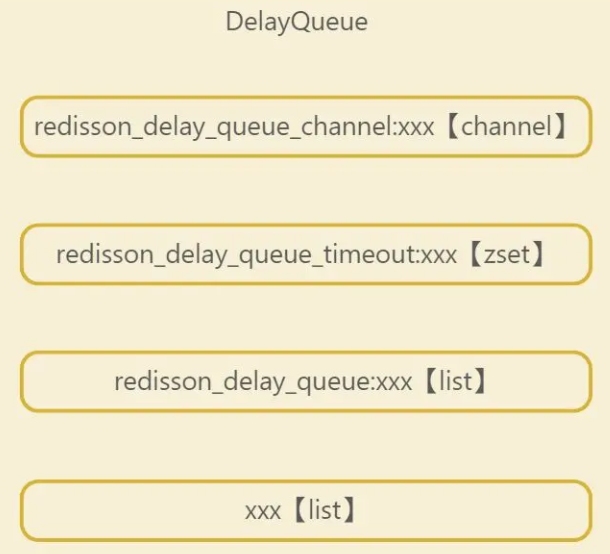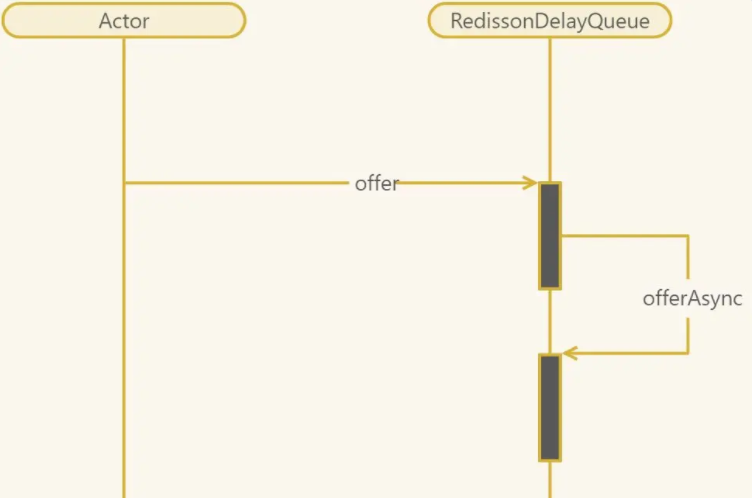How Redis implements delay queue
Use
Dependency configuration
<?xml version="1.0" encoding="UTF-8"?>
<project xmlns="http://maven.apache.org/POM/4.0.0" xmlns:xsi="http://www.w3.org/2001/XMLSchema-instance"
xsi:schemaLocation="http://maven.apache.org/POM/4.0.0 https://maven.apache.org/xsd/maven-4.0.0.xsd">
<modelVersion>4.0.0</modelVersion>
<parent>
<groupId>org.springframework.boot</groupId>
<artifactId>spring-boot-starter-parent</artifactId>
<version>2.3.12.RELEASE</version>
<relativePath/> <!-- lookup parent from repository -->
</parent>
<groupId>com.homeey</groupId>
<artifactId>redis-delay-queue</artifactId>
<version>0.0.1-SNAPSHOT</version>
<name>redis-delay-queue</name>
<description>redis-delay-queue</description>
<properties>
<java.version>1.8</java.version>
</properties>
<dependencies>
<dependency>
<groupId>org.springframework.boot</groupId>
<artifactId>spring-boot-starter-data-redis</artifactId>
</dependency>
<dependency>
<groupId>org.springframework.boot</groupId>
<artifactId>spring-boot-starter-web</artifactId>
</dependency>
<!-- https://mvnrepository.com/artifact/org.redisson/redisson -->
<dependency>
<groupId>org.redisson</groupId>
<artifactId>redisson-spring-boot-starter</artifactId>
<version>3.19.3</version>
</dependency>
<dependency>
<groupId>org.redisson</groupId>
<artifactId>redisson-spring-data-23</artifactId>
<version>3.19.3</version>
</dependency>
</dependencies>
<build>
<plugins>
<plugin>
<groupId>org.springframework.boot</groupId>
<artifactId>spring-boot-maven-plugin</artifactId>
<configuration>
<excludes>
<exclude>
<groupId>org.projectlombok</groupId>
<artifactId>lombok</artifactId>
</exclude>
</excludes>
</configuration>
</plugin>
</plugins>
</build>
</project>Note: Handle redisson and springboot compatibility issues
Configuration file
There are three ways for springboot to integrate redisson
The first: general redis configuration redisson automatic configuration [the simplest]
The second type: Use a separate redisson configuration file
The third type: Use spring.redis.redisson to configure under the configuration key
For detailed integration, view springboot integrated redisson configuration
spring:
redis:
database: 0
host: localhost
port: 6379
timeout: 10000
lettuce:
pool:
max-active: 8
max-wait: -1
min-idle: 0
max-idle: 8demo code
package com.homeey.redisdelayqueue.delay;
import lombok.RequiredArgsConstructor;
import lombok.extern.slf4j.Slf4j;
import org.redisson.api.RBlockingQueue;
import org.redisson.api.RDelayedQueue;
import org.redisson.api.RedissonClient;
import org.springframework.context.annotation.Bean;
import org.springframework.context.annotation.Configuration;
import org.springframework.stereotype.Component;
import javax.annotation.PostConstruct;
import java.util.concurrent.ExecutorService;
import java.util.concurrent.Executors;
import java.util.concurrent.TimeUnit;
/**
* 明天的你会因今天到的努力而幸运
*
* @author jt4mrg@qq.com
* 23:11 2023-02-19 2023
**/
@Slf4j
@Component
@RequiredArgsConstructor
public class RedissonDelayQueue {
private final RDelayedQueue<String> delayedQueue;
private final RBlockingQueue<String> blockingQueue;
@PostConstruct
public void init() {
ExecutorService executorService = Executors.newFixedThreadPool(1);
executorService.submit(() -> {
while (true) {
try {
String task = blockingQueue.take();
log.info("rev delay task:{}", task);
} catch (Exception e) {
log.error("occur error", e);
}
}
});
}
public void offerTask(String task, long seconds) {
log.info("add delay task:{},delay time:{}s", task, seconds);
delayedQueue.offer(task, seconds, TimeUnit.SECONDS);
}
@Configuration
static class RedissonDelayQueueConfigure {
@Bean
public RBlockingQueue<String> blockingQueue(RedissonClient redissonClient) {
return redissonClient.getBlockingQueue("TOKEN-RENEWAL");
}
@Bean
public RDelayedQueue<String> delayedQueue(RBlockingQueue<String> blockingQueue,
RedissonClient redissonClient) {
return redissonClient.getDelayedQueue(blockingQueue);
}
}
}execution effect

principle analysis
From RedissonDelayedQueueIn the implementation we see four roles

##redisson_delay_queue_timeout:xxx, sorted set data Type, stores all delayed tasks, sorted according to the expiration timestamp of the delayed tasks (the timestamp delay time when the task is submitted), so the first element at the front of the list is the earliest task to be executed in the entire delayed queue , this concept is very important
redisson_delay_queue:xxx, list data type, I have not found any use for the time being, but it will be written here when submitting the task, queue transfer The elements inside will be deleted
xxx: list data type, which is called the target queue. The tasks stored in this queue have all reached the delay time. Tasks that can be obtained by consumers, so the take method of RBlockingQueue in the demo above obtains the task
redisson_delay_queue_channel:xxx from this target queue, which is A channel used to notify the client to start a delayed task
RedissonDelayedQueueWhen the delayed queue is created, the queue transfer service is specified. As well as the four important color correction keys for implementing the delay queue. The core code is to specify the queue transfer task
QueueTransferTask task = new QueueTransferTask(commandExecutor.getConnectionManager()) {
@Override
protected RFuture<Long> pushTaskAsync() {
return commandExecutor.evalWriteAsync(getRawName(), LongCodec.INSTANCE, RedisCommands.EVAL_LONG,
"local expiredValues = redis.call('zrangebyscore', KEYS[2], 0, ARGV[1], 'limit', 0, ARGV[2]); "//拿到zset中过期的值列表
+ "if #expiredValues > 0 then " //如果有
+ "for i, v in ipairs(expiredValues) do "
+ "local randomId, value = struct.unpack('dLc0', v);"//解构消息,在提交任务时打包的消息
+ "redis.call('rpush', KEYS[1], value);" //放入无前缀的list 队头
+ "redis.call('lrem', KEYS[3], 1, v);"//移除带前缀list 队尾元素
+ "end; "
+ "redis.call('zrem', KEYS[2], unpack(expiredValues));" //移除zset中本次读取的过期元素
+ "end; "
// get startTime from scheduler queue head task
+ "local v = redis.call('zrange', KEYS[2], 0, 0, 'WITHSCORES'); "//取zset最小分值的元素
+ "if v[1] ~= nil then "
+ "return v[2]; " //返回分值,即过期时间
+ "end "
+ "return nil;",
Arrays.asList(getRawName(), timeoutSetName, queueName),
System.currentTimeMillis(), 100);
}
@Override
protected RTopic getTopic() {
return RedissonTopic.createRaw(LongCodec.INSTANCE, commandExecutor, channelName);
}
};
RedissonDelayedQueue#offerAsync
return commandExecutor.evalWriteNoRetryAsync(getRawName(), codec, RedisCommands.EVAL_VOID,
"local value = struct.pack('dLc0', tonumber(ARGV[2]), string.len(ARGV[3]), ARGV[3]);" //打包消息体:消息id,消息长度,消息值
+ "redis.call('zadd', KEYS[2], ARGV[1], value);"//zset中加入消息及其超时分值
+ "redis.call('rpush', KEYS[3], value);" //向带前缀的list中添加消息
// if new object added to queue head when publish its startTime
// to all scheduler workers
+ "local v = redis.call('zrange', KEYS[2], 0, 0); "//取出zset中第一个元素
+ "if v[1] == value then " //如果最快过期的元素就是这次发送的消息
+ "redis.call('publish', KEYS[4], ARGV[1]); " //channel中发布一下超时时间
+ "end;",
Arrays.asList(getRawName(), timeoutSetName, queueName, channelName),
timeout, randomId, encode(e));The above is the detailed content of How Redis implements delay queue. For more information, please follow other related articles on the PHP Chinese website!

Hot AI Tools

Undresser.AI Undress
AI-powered app for creating realistic nude photos

AI Clothes Remover
Online AI tool for removing clothes from photos.

Undress AI Tool
Undress images for free

Clothoff.io
AI clothes remover

Video Face Swap
Swap faces in any video effortlessly with our completely free AI face swap tool!

Hot Article

Hot Tools

Notepad++7.3.1
Easy-to-use and free code editor

SublimeText3 Chinese version
Chinese version, very easy to use

Zend Studio 13.0.1
Powerful PHP integrated development environment

Dreamweaver CS6
Visual web development tools

SublimeText3 Mac version
God-level code editing software (SublimeText3)

Hot Topics
 How to build the redis cluster mode
Apr 10, 2025 pm 10:15 PM
How to build the redis cluster mode
Apr 10, 2025 pm 10:15 PM
Redis cluster mode deploys Redis instances to multiple servers through sharding, improving scalability and availability. The construction steps are as follows: Create odd Redis instances with different ports; Create 3 sentinel instances, monitor Redis instances and failover; configure sentinel configuration files, add monitoring Redis instance information and failover settings; configure Redis instance configuration files, enable cluster mode and specify the cluster information file path; create nodes.conf file, containing information of each Redis instance; start the cluster, execute the create command to create a cluster and specify the number of replicas; log in to the cluster to execute the CLUSTER INFO command to verify the cluster status; make
 How to read redis queue
Apr 10, 2025 pm 10:12 PM
How to read redis queue
Apr 10, 2025 pm 10:12 PM
To read a queue from Redis, you need to get the queue name, read the elements using the LPOP command, and process the empty queue. The specific steps are as follows: Get the queue name: name it with the prefix of "queue:" such as "queue:my-queue". Use the LPOP command: Eject the element from the head of the queue and return its value, such as LPOP queue:my-queue. Processing empty queues: If the queue is empty, LPOP returns nil, and you can check whether the queue exists before reading the element.
 How to clear redis data
Apr 10, 2025 pm 10:06 PM
How to clear redis data
Apr 10, 2025 pm 10:06 PM
How to clear Redis data: Use the FLUSHALL command to clear all key values. Use the FLUSHDB command to clear the key value of the currently selected database. Use SELECT to switch databases, and then use FLUSHDB to clear multiple databases. Use the DEL command to delete a specific key. Use the redis-cli tool to clear the data.
 How to configure Lua script execution time in centos redis
Apr 14, 2025 pm 02:12 PM
How to configure Lua script execution time in centos redis
Apr 14, 2025 pm 02:12 PM
On CentOS systems, you can limit the execution time of Lua scripts by modifying Redis configuration files or using Redis commands to prevent malicious scripts from consuming too much resources. Method 1: Modify the Redis configuration file and locate the Redis configuration file: The Redis configuration file is usually located in /etc/redis/redis.conf. Edit configuration file: Open the configuration file using a text editor (such as vi or nano): sudovi/etc/redis/redis.conf Set the Lua script execution time limit: Add or modify the following lines in the configuration file to set the maximum execution time of the Lua script (unit: milliseconds)
 How to use the redis command line
Apr 10, 2025 pm 10:18 PM
How to use the redis command line
Apr 10, 2025 pm 10:18 PM
Use the Redis command line tool (redis-cli) to manage and operate Redis through the following steps: Connect to the server, specify the address and port. Send commands to the server using the command name and parameters. Use the HELP command to view help information for a specific command. Use the QUIT command to exit the command line tool.
 How to set the redis expiration policy
Apr 10, 2025 pm 10:03 PM
How to set the redis expiration policy
Apr 10, 2025 pm 10:03 PM
There are two types of Redis data expiration strategies: periodic deletion: periodic scan to delete the expired key, which can be set through expired-time-cap-remove-count and expired-time-cap-remove-delay parameters. Lazy Deletion: Check for deletion expired keys only when keys are read or written. They can be set through lazyfree-lazy-eviction, lazyfree-lazy-expire, lazyfree-lazy-user-del parameters.
 How to optimize the performance of debian readdir
Apr 13, 2025 am 08:48 AM
How to optimize the performance of debian readdir
Apr 13, 2025 am 08:48 AM
In Debian systems, readdir system calls are used to read directory contents. If its performance is not good, try the following optimization strategy: Simplify the number of directory files: Split large directories into multiple small directories as much as possible, reducing the number of items processed per readdir call. Enable directory content caching: build a cache mechanism, update the cache regularly or when directory content changes, and reduce frequent calls to readdir. Memory caches (such as Memcached or Redis) or local caches (such as files or databases) can be considered. Adopt efficient data structure: If you implement directory traversal by yourself, select more efficient data structures (such as hash tables instead of linear search) to store and access directory information
 How to implement redis counter
Apr 10, 2025 pm 10:21 PM
How to implement redis counter
Apr 10, 2025 pm 10:21 PM
Redis counter is a mechanism that uses Redis key-value pair storage to implement counting operations, including the following steps: creating counter keys, increasing counts, decreasing counts, resetting counts, and obtaining counts. The advantages of Redis counters include fast speed, high concurrency, durability and simplicity and ease of use. It can be used in scenarios such as user access counting, real-time metric tracking, game scores and rankings, and order processing counting.






